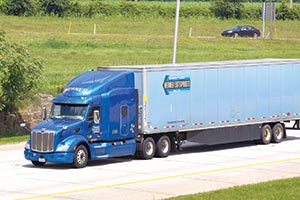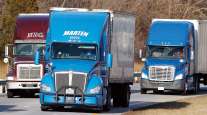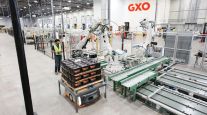Difficult Freight Market Hurts Truckload Earnings

This story appears in the April 25 print edition of Transport Topics.
The initial round of first-quarter truckload earnings sounded a negative note, with three of four large carriers reporting weaker results in a tough freight environment.
Knight Transportation Inc. reported that first-quarter net income declined 24%, citing excess capacity and inventory as well as weak industrial production. Werner Enterprises earnings dropped 13% and Landstar System Inc. profits fell 3%, as both companies reported pressure on rates. Only J.B. Hunt Transport Services improved earnings, with net income gaining 6%.
At Knight, revenue slipped 6.3% to $272.1 million, including fuel surcharges, and 1.4% excluding those fees. Net income was $22.6 million, or 28 cents per share.
“Freight volumes and revenue per loaded mile remained relatively stable during the first quarter compared with the 2015 quarter,” CEO Dave Jackson said about Knight, which ranks No. 31 on the Transport Topics Top 100 list of the largest for-hire carriers in the United States and Canada. “The more competitive freight environment and fewer noncontract opportunities have begun to pressure our overall revenue per loaded mile,” particularly citing more competition from brokers.
Knight attributed 7 cents of the earnings decline to a smaller gain on equipment sales, a higher tax rate and a loss from exiting the produce sourcing business.
Werner Enterprises, No. 16 on the for-hire TT100, earned $20.1 million, or 28 cents per share. Revenue there dropped 3% to $482.8 million.
“Our first-quarter 2016 freight demand was softer than the first quarters of 2015 and 2014,” Werner’s statement said. “However, it was consistent with our average freight demand in the first quarters of 2013 and 2012. Demand showed normal seasonality in first quarter 2016. Freight demand to date in April 2016 has been sluggish and softer than most April periods.”
Werner’s non-asset business doubled its profit before taxes and interest.
The worsening used-truck market also hurt Werner, based in Omaha, Nebraska, where gains on sale were reduced by $2.1 million and an unidentified major customer canceled a deal to buy several hundred trucks.
Both Knight and Werner anticipated a tightening of the market that should help fleets later this year, driven by the combined effect of looming regulations on ELDs and the sharp drop in new truck production that should further shave capacity.
“The truckload sector has been under increased fundamental pressure since the beginning of the year as a multitude of factors weigh in on the industry,” said a report from John Larkin, a Stifel Nicolaus analyst, citing the rate and freight environments.
No. 10 Landstar’s net income was $29.2 million, or 69 cents. Revenue there slipped 7% to $711.6 million.
Van freight revenue at Landstar, based in Jacksonville, Florida, fell 5% to $428.2 million as loads moved in that equipment rose 4%. Flatbed revenue was 13% lower at $209.4 million, but shipments rose 1%. Less-than-truckload linehaul loads rose 3%.
“Our truckload services experienced pricing pressure throughout the 2016 first quarter, as industrywide truck capacity was more readily available,” CEO Jim Gattoni said.
The first three weeks of the second quarter have produced a “low single digit” increase in loads.
No. 3 Hunt’s net income reached $100.1 million, or 88 cents, helped by stronger results at its dedicated and brokerage units and revenue rose 6% to $1.53 billion from $1.44 billion, a company statement said. The brokerage unit’s profit before interest and taxes climbed 63% to $10.8 million. Profit on that basis rose 25% at the dedicated unit to $44.8 million. Brokerage revenue rose 12% to $183 million, while dedicated revenue gained 4% to at $358 million.
Truck-rail profit at Hunt’s largest unit before interest and taxes slipped 1% to $103.1 million, but revenue was 2% higher at $895 million as shipments rose 12%.
“J.B. Hunt benefited from volume growth, improved network operations, higher equipment utilization, lower equipment maintenance costs and increases in contract pricing,” a report from Allison Landry at Credit Suisse said. “These benefits were partially offset by increased rail purchased transportation costs, higher driver wages and recruiting costs, increased costs of equipment ownership, and corporatewide technology upgrades.”




